MagnetoSpeed was at SHOT Show this year, displaying its magnetic field (read: no light necessary) chronographs and demonstrating them on range day. New for 2015 is the “Sporter” model, which is available for around $189. However, I’ve been so annoyed in the past few months attempting to use a traditional photo sensor chronograph in overcast weather, at the indoor range, or even in sunny weather with roving clouds and moving shadows that I picked up the top-of-the-line V3 model ($399). I hoped it would pull its weight and ensure that wasted 2-hour round-trip drives to the woods were a thing of the past. What I’ve found is. . .
https://www.youtube.com/watch?v=v5IXXfuTCOc
It’s awesome. Better than I expected, and based on what I had seen at SHOT Show and in a few reviews online, I had fairly high expectations to begin with. If you watch only 15 seconds of the video above, click here to skip to what I’d say is the most impressive part.

The MagnetoSpeed bayonet attaches to the barrel of your firearm. It can also be strapped to a suppressor or clamped to a picatinny rail. It uses sensors to detect changes in the magnetic field as a bullet passes over the bayonet. The V3 comes with three spacers and two rubber pads, all of varying thickness, which can be combined as needed to achieve appropriate spacing between the bayonet and the bottom of the firearm’s bore (bottom of the bullet).
Ideal spacing is 1/4″ down to 1/8″, and the kit ships with a 1/4″-thick aluminum bar to check spacing and help ensure that the bayonet is straight so you don’t shoot it. If you’re not sure, a cleaning rod — or the aluminum bar if your bore is larger than 1/4″ — can be inserted in the bore to approximate the bullet’s trajectory.
Should the need to mount the bayonet on a tapered barrel arise, MagnetoSpeed sells tapered spacers (the two red ones seen in some of the photos). These can be stacked in either direction to create various degrees of cant.
Also included in the kit is a heat shield for the strap itself if rapid fire and a hot barrel or suppressor is in the cards. The strap is standard 1″ webbing though, so it’s easily replaced if it came to that.
One add-on I definitely wanted was the picatinny rail adapter, which has worked great so far on a couple of standard pistols (CZ, GLOCK) as well as on a not-so-standard pistol:
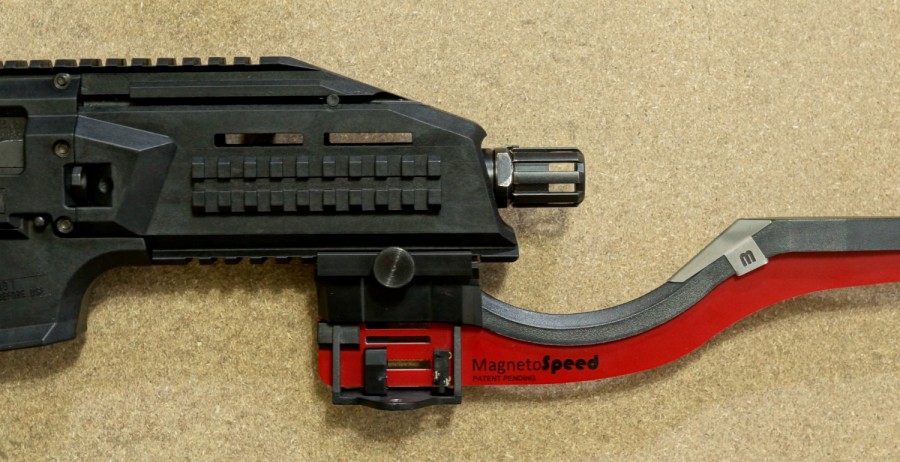
In actual practice, I’d likely mount the bayonet on one of the side rails instead of the bottom rail. It has no up or down. This 360° ability may also come in handy on some shotguns and other firearms:
The red part of the bayonet itself is cut from a sheet of fiberglass. It’s light weight, but stiff, and feels very strong. Using the MagnetoSpeed on shotguns or with muzzle brakes, as seen above, is a-okay.
Overall I think the physical design is extremely good, and there was clearly a lot of thought that went into making it easy to use. For instance, tighten the strap by hand and then follow up with a few turns on the knob to make sure it’s fully secure. Extra strap length is kept out of the way by routing it through a slot on the other side.
Even cooler than strap management are the redundant ports for the data cables. They both do the same thing and only one is used while chronographing, but with one on the back and one on the bottom you’re significantly less likely to run into some sort of clearance issue.
Also worth noting is that both cables have one 90° end and one straight end, and it doesn’t matter which end goes in the bayonet and which end goes in the display unit. The kit comes with two cords — one a lightweight retractable job and the other a 6-foot standard cord.
The display unit turns on automatically when the cable is inserted. It is the control center, the brains of the system, and the data logger. It saves data — shot velocity (ft/s or m/s), maximum velocity, minimum velocity, average velocity, standard deviation (SD), and extreme spread (ES) — on a Micro SD card. The menus and settings are very easy to navigate, and the owner’s manual is actually quite excellent as well. The quick start guide is exactly what a quick start guide should be.
One 9v battery or two CR123s can be used to power the display unit. A backlight can be turned on if desired.
On The Range
In practice, the MagnetoSpeed was a joy to use. It picked up every last shot and instantly had all of the data available to scroll through on the display. Pressing the up or down arrows scrolls the shot velocity history on the left side, while min, max, and SD or ES stay fixed on the right. Regardless of whether you have it set to display SD or ES, both will be saved to the Micro SD card when you archive the data.
The only “complicated” adjustment you may have to make is tinkering with sensitivity. The normal sensitivity mode — setting 2, or just select “normal” — is supposed to work in the vast majority of cases and, indeed, worked flawlessly on my AR-15 with three brands of ammo including during rapid fire as seen in the video. Of course, considering it will collect data at up to 1,100 rounds per minute, this shouldn’t be a surprise.
For smaller bullets, some cast lead bullets (no jacket, no plating), less-than-ideal distance between bayonet and bore, etc, the sensitivity goes up to 11.
With the rail mount on my SP-01 with .22 LR Kadet Adapter installed, the spacing was a bit over the suggested maximum and, of course, .22 LR bullets are small. On normal mode it didn’t pick up a bare lead bullet, so I bumped the sensitivity up to the middle of the range and it never missed another shot. For most centerfire ammo, the setup process is strap it on, plug it in, and shoot.
Perhaps the most enjoyable aspect of collecting data with the MagnetoSpeed system is that you’re free to move around and have fun target shooting at the same time. Shooting over the two photo sensors of a traditional chronograph requires precise and careful alignment — I admit it! I’ve shot and destroyed a chronograph before! — so once it’s set up you’re fixed in place. Basically, the ammo I used to use for chronograph work really served no other function. Yes, it’s possible to set up with a target down range and, for instance, sight in a rifle while collecting photo sensor chrony data, but aligning gun, shooting bench, chronograph, and target is not the easiest of feats. With the lightweight bayonet strapped to your firearm and 6 feet of cord, you can go about your normal shooting while collecting data. Heck, toss the display unit in a pocket and you’re chronographing on the go.
Of course, we also come back full circle to my impetus for getting the MagnetoSpeed in the first place. This magnetic sensor chrony is not dependent on light conditions. It just works. Even with ideal light I’m used to occasional missed readings and other failures with a photo chrony due to shots that aren’t perfectly centered and debris from muzzle blast passing the sensors, etc. “Ideal light” is also pretty specific — indirect sunlight, basically. Moving your entire setup because the sun has moved and now your chrony shades aren’t blocking the sensors or a tree shadow comes into play or clouds keep changing the lighting really just sucks. “Just use a collapsible gazebo,” they say. How about I take the chronograph out for dinner first? Yeesh. One MagnetoSpeed, please.
Drawbacks
There are things one can do with a normal chronograph that cannot be done with the MagnetoSpeed:
- The MagnetoSpeed can’t be placed downrange to provide information on projectile velocity at a given distance. It does muzzle velocity.
- There will be firearms that the MagnetoSpeed just can’t attach to. Revolvers with short barrels (the few that lack side rails like the Sky Marshal, of course), rifles with extended handguards that would space the bayonet too far away from the bore if it were strapped to the handguard, most semi-automatic pistols without an accessory rail (the exception being various .22 LR models that don’t have a reciprocating slide), compact pistols with small accessory rails, etc.
- If many firearms are to be chronographed in one outing, it would be quicker with a chronograph that isn’t attached to the gun.
At $189, the Sporter model is in the ballpark with nice photo sensor chronographs. The $399 V3 model ain’t cheap. It is pretty freaking awesome, though.
I’d like to see a WiFi or Bluetooth connection on the “V4” chronograph. Ditch the cord and ditch the display unit; let’s log directly to a phone, tablet, or laptop.
Ratings (out of five stars):
Reliability * * * * *
I have never had such reliable success picking up every single shot over a chronograph. Let alone rapid fire shots. Even in perfect lighting conditions.
Accuracy * * * * *
Obviously this is somewhat difficult for me to verify. Standard deviation results were totally in line with my photo sensor chronograph for the ammunition types that I’ve shot over both. Velocity measurements are very close, but I have no way to know which one is closer to the actual numbers. However, on the day I was shooting I do know that the speed of sound was below most of the Winchester 555 .22 LR shots but above a couple of the shots. This was completely apparent due to the sonic boom from the supersonic shots. According to my calculation of the speed of sound on that day, the MagnetoSpeed readings perfectly bore out the real life fact that some of the rounds were below the speed of sound and most were over it.
Ease of Use * * * * *
Properly mounting the bayonet was much simpler than I was expecting. Properly configuring the unit couldn’t be easier. Collecting data while shooting is actually fun. Not worrying about aligning each shot perfectly every time or suffer shooting your chronograph? Weight of impending doom lifted off my shoulders.
Price * *
More expensive than traditional chronographs. At the time of this writing, it’s on sale at MidwayUSA for $349.99.
Overall Rating * * * * *
I’m really happy right now. We’ll be seeing a lot of this MagnetoSpeed V3 in the future as I use it for basically everything that will benefit from chronograph data.

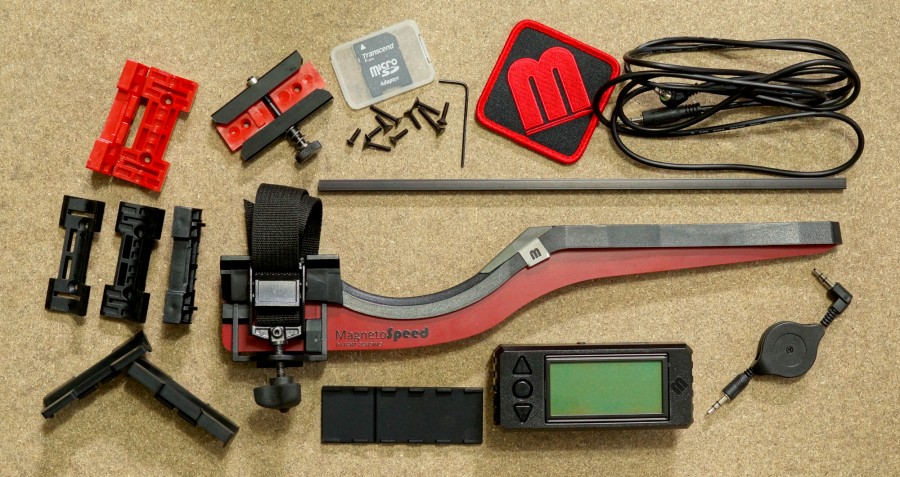

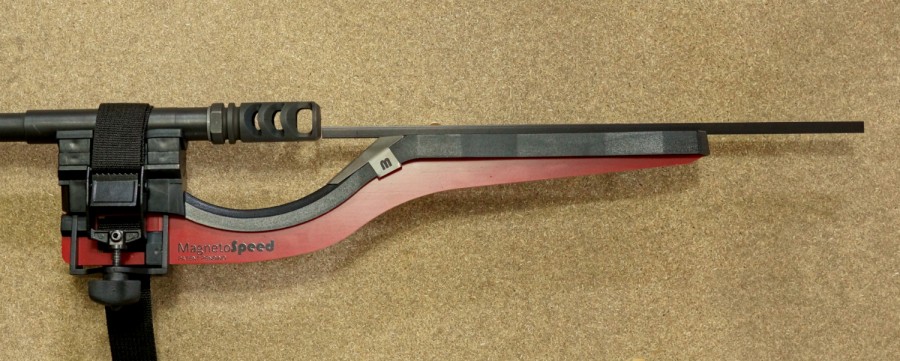

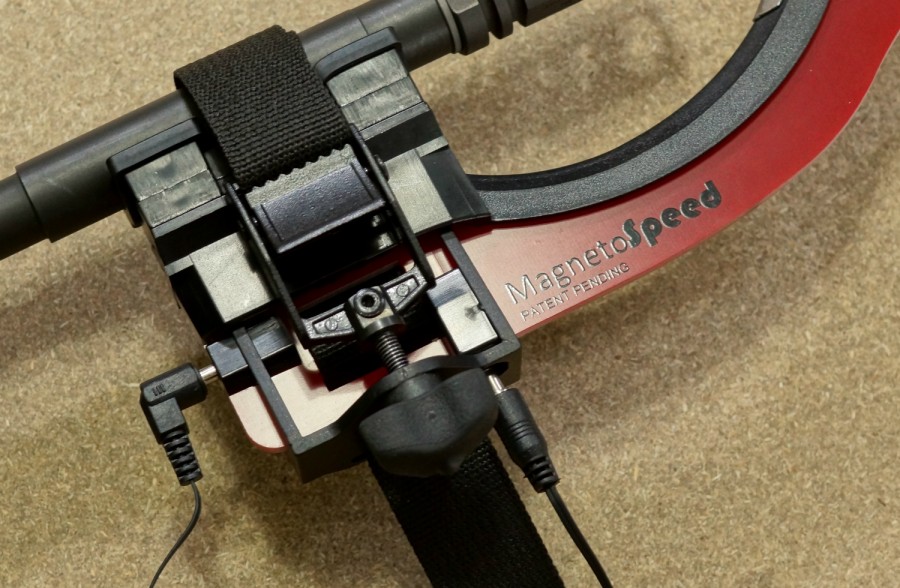
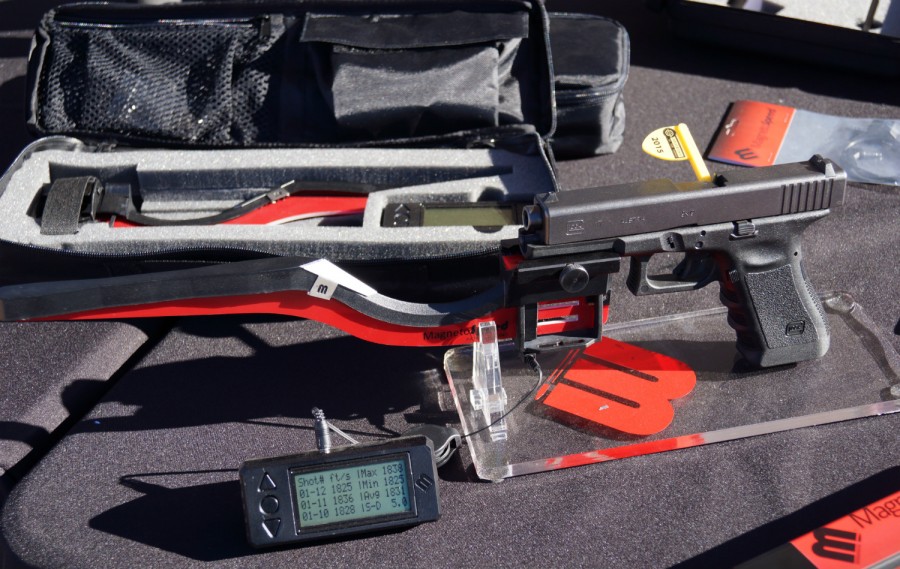



Awesome review! Thorough to say the least, i have had one of these on my list for hand loading for a while now and it good to see such a comprehensive review. I have access to a PVM-21 infrared chronograph so weather/sunlight has never been an issue but A) it isn’t mine and B) the indoor range where I do most of my load work doesn’t let you in front of the firing line so I still have to find somewhere outdoors when I am doing initial workup to find max pressure/velocity. Reloading without a chrono is a fools errand as most primers don’t crater/ bolts don’t get sticky until well above bad pressure. You ABSOLUTELY have to have a chrono when working up a new load. Otherwise you are just guessing what your velocities and pressures are.
So thanks again Jeremy, you just made me $400 poorer. 🙂
Very cool. I’ve been waiting to see a review of these. I kind of broke my older chrony with the .50.
I have the V1 version and love it. I have been trying to avoid reasons to buy another one! It’s the best chrony I’ve ever owned.
Sorry about the dead link in the “Accuracy” rating section. It’ll function tomorrow, as it’s actually linking to a TTAG article that isn’t publishing until tomorrow 😉 …the video part of that article is here, though, in case anyone is interested.
Why don’t you just make ten louder and make ten be the top number and make that a little louder?
… These go to eleven.
Damn….. beat me to the Spinal Tap reference.
Has to be the reason that it goes to 11.
https://www.youtube.com/watch?v=KOO5S4vxi0o
Werd. This thing really does go up to 11, but the actual Spinal Tap reference was worked into this article 😉
Apparently there’s actually a very good reason why the vast majority of red dots, illuminated reticle scopes, and things like this chrony have 11 adjustment settings. I guess it has something to do with an algorithm that scales power consumption or whatever in some sort of specific exponential fashion and it results in 11 settings and basically everyone uses the same thing for this sort of functionality.
The reason is pretty simple.
That way you have the same number of positions on either side of the nominal zero:
-5 -4 -3 -2 -1 0 1 2 3 4 5
Any odd number will work, actually, to give this behavior.
That makes sense, but that isn’t the reason. I mean, like 99% of red dots on the market have 11 brightness settings. If the reason was just even choices on either side of a norm, you’d see 5 and 7 and 9 and whatever. There’s something about an algorithm for 11 that is the reason all of these products have 11. That said, I only heard this verbally from an optics manufacturer and can’t back it up with any sort of documentation or whatever. But it’s more than a coincidence that 11 is the number.
Nice review.
I can certainly see the advantage if you’re regularly doing reviews and handloads. For me just checking some speeds for suppressor ammo the Caldwell with cord to smartphone seems a steal at $89,
It’s inevitable that the next version will be wifi to your smartphone.
Waiting for that if I’m going to spend that kind of coin.
Jeremy,
That looks really nice. But I’m curious about your take on this. You either have a chronograph problem or you have an ammunition problem. The extreme spread in the rapid fire portion you did around 10:00 was 211 FPS!!!! Thats very very high. Either you were mixing 55 grain ammo with 77 gr ammo in that mag or something is not right.
One thing that would be a VERY useful test is to shoot a rifle over the magnetospeed and then through normal Chrono sky screens and see how close each method measured when measuring the same shots.
Is there any chance of us getting you to do that? I
Don
I’ve actually done that. My average difference was 10-15 FPS with my screen chrony about 25 feet away. I ended up selling my traditional chrony.
Ammo. Those are really cheap reloads from Freedom Munitions back when they did their “blaster” ammo, which was basically like “scratch & dent” haha. I have never ever had a single hitch with them whatsoever, but they are really inconsistent. That result is not different from what I saw with this ammo over a normal photo sensor chrony.
I’ve shot a significant amount of the Silver Bear, M855 of this same brand, Freedom Munitions, and both .22 LR loads that were in this video over my previous chronograph as well. The information from both is very close. Velocity is just slightly higher on the MagnetoSpeed but, of course, it’s at the muzzle whereas the normal chrony is 10′ to 15′ or so away from the muzzle typically. Things like extreme spread and standard deviation are effectively identical.
Originally, my plan was to shoot through the photo chrony with the MagnetoSpeed on the muzzle as well and compare the numbers from the exact same shots against each other. The real problem is that there’s no way to know which is correct, or closer to correct, should the numbers differ. And the photo chrony is more likely (IMHO) to get false readings due to debris from the muzzle blast and other environmental factors but, still, should they differ then what is the takeaway? I kind of feared a lot of people would simply “trust” the photo once since it’s been the standard for a long time and the MagnetoSpeed is voodoo science. Or not. But, still, I thought about it and it didn’t really seem relevant. I feel like I’d have to shoot the MS unit and compare it to some legit scientific measuring instrument that was calibrated and known for sure to be correct… and I don’t have that.
Mentioned in the ratings section, I’m confident in these readings because I can calculate the speed of sound based on the temperature that day and I know for a fact that the Win 555 out of the pistol was straddling the speed of sound — sometimes breaking it and sometimes under it. The results on the MagnetoSpeed chrony were completely in-line with this.
Jeremy,
Thanks for the response. Your comment about uncertainty with photo chronos is what makes the old standard the BEST light based chrono around. Oehler uses 3 sky screens. So for every shot taken, it gets two measurements. One on the interval between 1 and 2 and the second measurement on the interval between 2 and 3. Unfortunately its up in the $1000 range.
And discontinued
That is definitely a cool machine.
Does the Magnetospeed affect point of impact, group size, and/or barrel harmonics? I chronograph almost everything with either my Oehler 35P, or PVM-21, but setting up at the range is time-consuming, especially when there are other shooters.
Great review.
I borrowed one when I was putting together dope for the Bushnell Brawl and the owner mentioned that sighting in with the Magneto Speed attached to the barrel would be a “rough in” and it sends rounds high vs not having it attached. Just for giggles, I tried it out and it does indeed change POI.
The bayo doesn’t weigh much, but on some — not all — guns it will affect point of impact. It is not, however, expected to impact group size or repeatability. You should be able to shoot for groups and load development with it on, and the worst case scenario is that POI shifts slightly without it on.
Clamping a mass to the barrel changes harmonics even if it doesn’t change POI significantly it could affect group size. Google the browning BOSS chassis system to get an idea of the effect. A lot of load development comes from tailoring the load to the barrel harmonics. thays why BR shooter talk about nodes. You could get a pretty tight group only to have it open up on you when you take your chrono off.
Would be wise to shoot initial load workup as you check for pressures and velocity but then take it off for tuning the load. Once you have it grouping like you want to put it back on if you need to know final velocity and es/sd etc.
when working up loads on my Tikka 6.5 Swede was having a hard time getting good groups
I had a new Veracity FFP 2-10 and thought the scope was defective
went to the range yesterday and shot series of 5 rounds first two with the V3 magneto speed
to get a idea of the velocity of the rounds and the final three without the V3
impact was three inches high and to the left on all six five shot series
Repeated test with my Browning 6.5 Creedmoor
It has a 26″ barrel and this is a highly accurate rifle
It was almost identical to the tikka so i will use three shot series to determine the velocity and go from there
This V3 is so easy and fast to move from rifle to rifle it is worth this minor drawback
Thanks for the review. I want one.
On sale for 350.00 at Midway right now. 😉
Thanks! I saw that a few days ago and meant to add it here but forgot! Edited the post to add it to the ratings section 🙂
I have used the V2 for over a year, and it is excellent. Simple to use and so far has been 100% reliable.
My experience was POI moved 3/4″ up and seemed to have no effect on group size. When comparing to my CE ProChrono, the widest variance was 8 fps and the smallest was 0. This test was done with a RRA LAR 8 and identical handloads.
This is a terrific piece of equipment. So much easier and quicker to set-up than a traditional chrony, and gives a reading every shot regardless of light conditions.
I really like this cronograph and would recommend it to anyone who is a series shooter. I only have one beef with it, and that I have a problem keeping it tight on the end of my tappered barrel. I’M thinking of using a velcro strap to hold the cronograph in place. I just hope this will work.
Has anyone tried pulling the data into an Excel Spreadsheet? I haven’t gotten around to try it myself. At some point the chip will fill up and need to be cleared. I suppose the data could be transferred to a computer hard drive. I wish it could go directly to one of those iPhone or lPad ballistic programs,.
Obviously the muzzle velocity is the primary piece of the performance puzzle, it verifies reloading data and is usually the only speed asked for with basic ballistic calculators. For people who can shoot sub-MOA groups placing a chronograph downrange at 100 yards or more can be something of a challenge at most ranges. That said some can and a downrange chronograph will help verify BC for a given bullet: you need both muzzle AND downrange speed for that determination.
So, why not get the best* setup for the muzzle reading and something less expensive to replace for that downrange unit. *best meaning the only one you can set up at any range, indoor or out, without shutting down the line while you set up and adjust everything…
I’ll let you know if this isn’t a good investment after ours arrives: getting the V3.
I don’t think it would be ideal to use a magnetospeed device at the muzzle and a reflective chrony downrange (say at 50 or 100yds) to determine BC for 2 reasons:
1) You’re using two different devices to measure the same bullet. If both devices have a natural offset between them, then that offset will effect the BC calculation. There’s no truly good way to accurately determine that offset either… you’d want them to both measure the same shot at the same point in space. The reflective chrony has a hard time taking reading directly at the muzzle due to blast and the magnetos cant take readings anywhere but at the muzzle.
2) Hanging anything off your muzzle will change your POI. You might be able to shoot sub-MOA, but that magneto thing can change your POI and you can hit your reflective chroney unintentionally.
Best to just use the chronograph in two different spots on the range for BC calculation. Personally, I’ve always liked measuring the muzzle velocity for a shot and measuring the drop at one distance… and then measuring the velocity and drop at another distance from the same load. Then you should be able to determine the BC necessary to produce these numbers without dragging chronographs all around the range.
yeah but if you testing at 15 meters or less and you don’t care about ballistic coefficient then this seems like a great indoor solution.
I am trying to set up my lab in a indoor space and I was considering many options infrared screens, mounting led lights and taking the florescent ones out, ect.. I run a lab that shoots body armor and after watching this I am sold. I bet I love when I get it.
VIDEO LINK PROBLEM: The link in the article no longer works the way it’s supposed to, and the video is really, really long. The link used to take us to the exact best part of the video, but now it just takes us to the beginning.
I’m referring to the CLICK HERE link:
“If you watch only 15 seconds of the video above, click here to skip to what I’d say is the most impressive part.”
I’m not going to sit around all day watching videos and getting fat. Can anyone post a response and give us the exact time mark in the video that Jeremy S. was recommending?
Thank you, everyone.
Comments are closed.